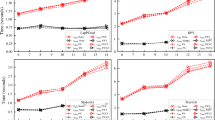Abstract
A procedure for the analysis of 3D Stokes flow around complex micro structures (MEMS) is developed with the aim of evaluating damping forces. First kind integral equations employing single layer potentials are utilized and the linear system stemming from their discretization is solved by a GMRES iterative procedure with multipole accelerators. Issues pertaining to the conditioning of the linear system are discussed with reference to the examples presented.
Similar content being viewed by others
References
Biros G, Ying L, Zorin D (2003) A fast solver for the Stokes equations with distributed forces in complex geometries. J Comput Phys 193:317–348
Frayssé V, Giraud L, Gratton S, Langou J, (2003) A set of GMRES routines for real and complex arithmetics on high performance computers. CERFACS technical report TR/PA/03/3
Gomez JE, Power H (1997) A multipole direct and indirect BEM for 2D cavity flow at low Reynolds number. Engng Analysis with Boundary Elem 19:17–31
Ingber MS, Mammoli AA (1999) A comparison of integral formulations for the analysis of low Reynolds number flows. Engng Analysis with Boundary Elem 23:307–315
Milroy JS, Hinduja S, Davey K (1997) The elastostatic three dimensional boundary element method: analytical integration for linear isoparametric triangular elements. Appl Math Modelling 21:763–782
Mammoli AA, Ingber MS (1999) Stokes flow around cylinders in a bounded two-dimensional domain using multipole-accelerated boundary element methods. Int J Num Meth Engng 44:897–917
Nishimura N (2002) Fast multipole accelerated boundary integral equation methods. Appl Mech Reviews 55:299–324
Power H, Wrobel L (1995) Boundary Integral Methods in Fluid Mechanics. Computational Mechanics Publications, Southampton
Pozrikidis C (1992) Boundary Integral and Singularity Methods for Linearized Viscous flow. Cambridge University Press, Cambridge
Steinbach O, Wendland WL (1998) The construction of some efficient preconditioners in the boundary element method. Adv Comput Math 9:191–216
Tausch J (2003) Sparse BEM for potential theory and Stokes flow using variable order wavelets. Comput Mech 32:312–318
Wang X (2002) FastStokes: a fast 3-D fluid simulation program for micro-electro-mechanical systems. Ph.D. Thesis, M.I.T., Boston
Author information
Authors and Affiliations
Corresponding author
Rights and permissions
About this article
Cite this article
Frangi, A., Gioia, A. Multipole BEM for the evaluation of damping forces on MEMS. Comput Mech 37, 24–31 (2005). https://doi.org/10.1007/s00466-005-0694-1
Received:
Accepted:
Published:
Issue Date:
DOI: https://doi.org/10.1007/s00466-005-0694-1




